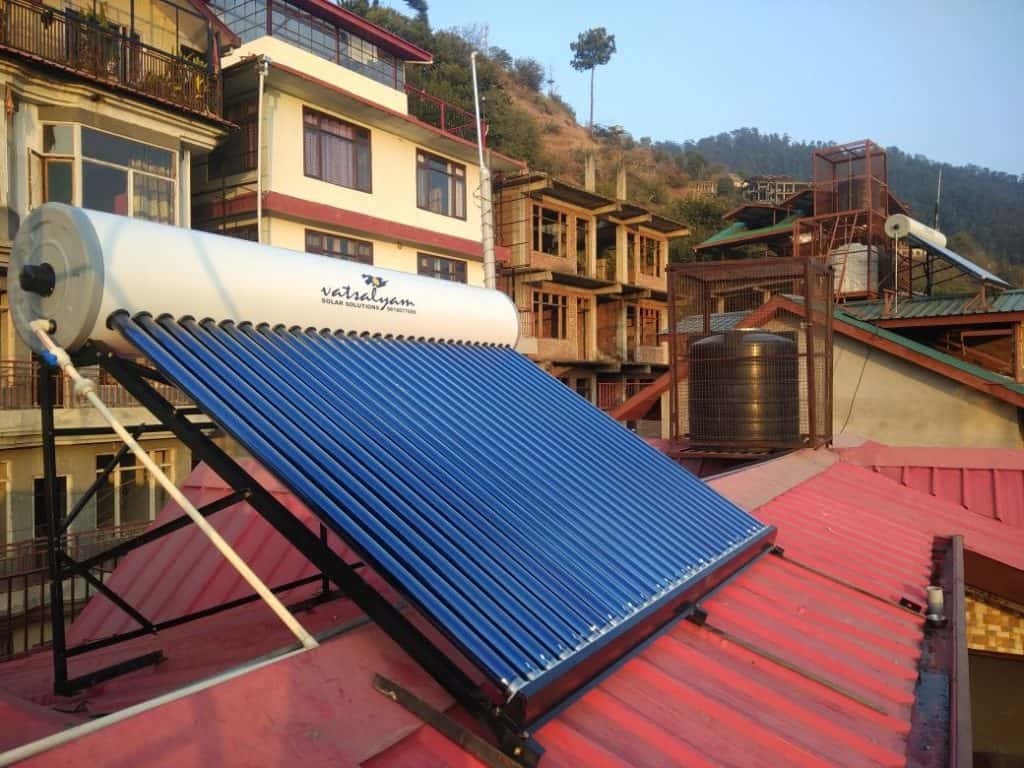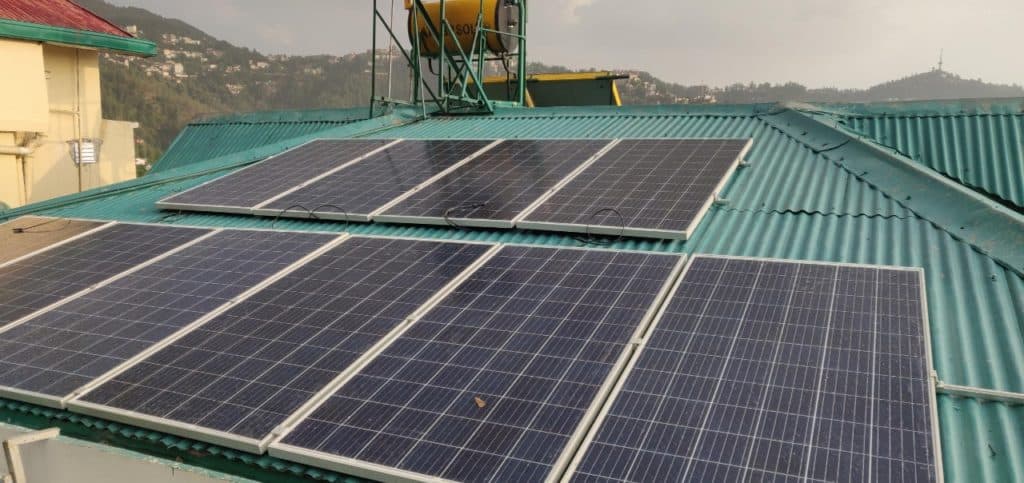This article is part of our special series Environmental Sustainability & Climate Change in Tier II cities supported by Climate Trends.
The colonial summer capital is taking some key steps on the energy front in its goal of becoming a green city. Presently, 67 government buildings are switching over to solar power and more than 1,000 street lights are working on solar energy. Also, dozens of city hotels are maximising their use of solar energy systems, while several residential buildings have installed photovoltaic technologies to cut down their monthly power bills.
“This is our 2021-22 mission for a green city project for which Rs 6 crore has currently been set aside out of Rs 2,900-crore worth smart-city projects,” said Pankaj Rai, then Commissioner, Shimla Municipal Corporation and head of the smart city projects. “The rest of the funding — Rs 12.85 crore — has been sought from the Centre.”
The plan, says Rai, envisages switching to low-cost, alternative energy practices for institutional buildings and citizen-centric services. Private residences will be given a choice of solar power designs to install in their homes, resulting in an overall saving of around Rs 1.5 crore a month. The Shimla Municipal Corporation bylaws now have made it mandatory for every new building to have solar energy technology/or solar grid-connected photovoltaics system to get building approval.
Some landmark buildings and institutions already using solar energy solutions
- Himachal Police headquarters
- Health Directorate
- Directorate of Rural Development building
- HIMURJA – an energy agency
- Directorate of Environment, Science and Technology
- RKMV college
- HP University
- Portmore and Lalpani Schools
- Himachal Pradesh High Court
Himland, a privately-owned hotel located on Shimla’s Cart road, is among the pioneers in solar use, having used solar water heating systems for almost 15 years. Bishop Cotton School, one of Asia’s oldest schools, St Bede’s college, Auckland House and a few other hotels and banks have also installed solar panels.
Ignored and untapped for the past few decades, the potential of solar power and other unconventional renewable energy systems to power Shimla and other urban centres is only now being realised.
“Sunshine in Shimla is available for almost 325 days, which is much better than any other town,” says Asheesh Sharda, a young entrepreneur, whose home is run entirely on solar systems. And with more people willing to adopt solar systems, “solar power has really changed the face of Shimla. It is clean energy, cheap and readily available, in and around you”.
Sharda’s energy company, Shimla-based Vatsalya, has around 2000 clients, as more homes and institutions try to reduce their dependence on the HP State Electricity Board (HPSEB) by installing solar systems. The resultant drop in power bills has been a major motivator, especially for water heating and lighting systems. Umesh Akre, a leading hotelier, says the reduction in cost has already covered the additional investment incurred in his hotels.

“Shimla requires hot/warm water almost throughout the year,” says Vineet Sood, project officer at HIMURJA – a statutory government agency handling the Solar energy operations in the state. “Fortunately, Himachal Pradesh is a power surplus state. And the increasing use of solar energy in Shimla is leading the drive to make it a green city.”
Exporting green energy
The conversion to solar power is unlikely to have any visible impact on Shimla’s air quality which remains fairly clean except during the peak tourist season when vehicular pollution is at its highest. Burning of charcoal for winter heating is totally banned anyway. And the move towards solar energy will help Himachal Pradesh earn more revenue from increased availability of surplus power for export to other states.
Being a power surplus state, power tariff in Himachal Pradesh is heavily subsidised. Charges range between Rs 1 per kWh to Rs 4.40 per kWh for different categories including domestic, defined as lifeline category, which consumes 34% of the power produced. Additional Chief Secretary (Power) Ramsubhag Singh says Himachal Pradesh has 900 million units of surplus power which generates revenue from its sale to other states
Studies have shown that the state has enormous solar power potential and can easily generate at least 50 MW of solar power by getting the right expertise and funding. Especially since solar power is costly and there is a need for subsidy or other grants.
Dr S S Chandel, an expert on solar energy recalls having done a study of solar power potential during his term as Professor, Centre for Energy and Environment at National Institute of Technology (NIT), Hamirpur. The study was submitted to the state government in 2017 as a policy paper for prospective planning in the area of renewable energy. Dr Chandel admits that the subsidy component is the key to encouraging citizens, the corporate sector and public and private institutions to switch over to solar energy.
“There is a subsidy scheme,” says Rupali Thakur, Chief Executive officer (CEO), HIMURJA. “During phase one ( 2011-12 ), the government successfully ran a scheme to provide 80% subsidy (70% from Centre, 10% from state) to institutions and residential buildings.” Under Phase-I, nearly 8 MW capacity Grid Connected Rooftop Solar (GCRTS) systems were installed for domestic and institutional buildings, of which 2.5 MW was in Shimla.

However, in 2017, the government of India (GoI) slashed the subsidy of 70% to 40% while the state government retained its 10% subsidy. This did cause some set-back to the drive to cover domestic/residential buildings under Shimla Municipal Corporation and in Dharamshala, beside 237 panchayats in Mandi district and 226 in Una in taking advantage of the scheme.
The subsidy, currently at 50 per cent is important to incentivise people as it costs Rs 42,000 per kwh. The average cost for a home installation is around Rs 3 lakh. Last year, the government spent Rs 31 crores as subsidy to those installing solar systems .
The union ministry of New and Renewable Energy Resources has given a target of 15 MW to the state government to cover Shimla and other major towns, and panchayats under the GCRTS, which will This will cost Rs 61 crores. Anyone applying for the Solar energy solutions is required to take NOC from the HP State Electricity Board (HPSEB), approval from HIMURJA and get the system installed from firms empanelled for the job .
According to Dr Ashwani K Sharma, Executive Director (HPSEB), there is reduction of nearly 18 per cent in the power supply to the town, “a clear indication that citizens are changing over to use of renewable energy through their Grid Connected Rooftop Solar (GCRTS) system. There is also an advantage in the Grid connected system that if the house owner is not utilising the full capacity of solar energy generated at home, he can transfer the surplus power to the HPSEB and claim a discount in his power bill”.
Future plans
At the larger policy level, the Union Ministry of New and Renewable Energy has sanctioned a 1000 MW capacity Solar park at Kaza in Lahaul Spiti district under Ultra Mega Renewable Energy Power park scheme. Beside 10 other MoUs were signed in 2019 with the private players to produce 480 MW of solar power .
“Once the projects of larger capacity get going, it will change the face of the state,” says Dr S S Chandel. “But the sector needs to be suitably subsidised and more ‘green cities’ need to be developed as proposed for Shimla and Hamirpur.”
Himachal Pradesh has the potential to generate 27,436 MW in the hydropower sector of which the state, central and private sector have been able to harness 44 per cent. But some scientists have argued that increasing this could have an adverse environmental impact even as work is on for another 10,000 MW of hydro power. There are no plans to harness wind energy.
Moving to solar could perhaps prove a greener choice than other renewable options.
Also read: